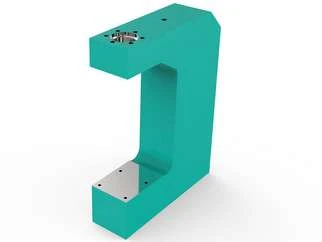Hydraulic presses with C-frame frames are very frequent. These presses are named for the fact that they are fashioned like the letter "C," although they are also known as gap-frame presses.
C-frame presses are designed to take up less space on the floor than conventional metalworking machinery while still delivering excellent functionality and low stroke deflection. C-frame presses, like other hydraulic presses, are extremely adaptable and can be utilized for a wide range of applications in a variety of industries.

C-Frame Press Design
While the design of a C-frame press might vary, the basic components are a steel framework, hydraulic cylinder, and upper and lower platens. The sliding table and the bolster table are the other names for these tables. Because of its advantageous properties and strength, A36 steel is commonly used for the press frame, making our hydraulic C-frame presses suited for stamping applications.
The press\'s three open sides allow it to handle a wide range of applications, including a wide range of material forms and sizes. Although there are rare exceptions, C-frame presses are commonly used for applications that need smaller bed diameters and lower tonnages.
Benefits of a C-Frame Press
In addition to the wide area created by its design and the possibility to operate manually or automatically, C-frame presses provide a number of other advantages to producers, including:
- Minimal Floor Space
Because of their small and robust C-shaped frame, C-Frame presses take up less floor space than most other hydraulic presses (such as 4-post presses).
- Ease of Use and Efficiency
The press\'s design allows for less stroke deflection, larger open area, and improved work approach.
- Access Points
C-frame presses include three access points to the operations area, allowing for quicker die maintenance and adjustments, as well as scrap metal and finished part removal.
Applications of a C-Frame Press
C-frame presses may handle a wide range of tasks. Stamping is one of the most typical applications. Stamped pieces from the C-frame press are made utilizing sheet metal such as copper, titanium, stainless steel, or aluminum during the stamping process.
The parts from the inserted sheet metal are shaped using a press tool known as a die. The sheet metal is then pushed into the die, forming the desired shape.
Bending
It is the process of stretching a material, commonly a flat sheet or strip of metal, by rotating it around a straight axis while applying tension. After the applied stress is removed, the bend is permanently fixed.
Blanking
It is the process of removing a portion of metal and keeping it. The remainder of the material is thrown away as scrap.
Compaction
The compression of powdered material into a solid object, usually using a bespoke hydraulic compaction press.
Crimping
It is an assembly process that involves folding and flattening material using a bespoke assembly press and an appropriate tool so that two components are securely linked together by pinching action. Sheet metal pieces are routinely joined using this method.
Conclusion
Aerospace manufacturing, appliance manufacturing, automotive manufacturing, ceramics, food and beverage processing, industrial, marine, medical, military and defense, packaging, and pulp and paper are just a few of the industries that use C-frame hydraulic presses.
Assembly, stamping, and trimming are some of the most popular hydraulic press uses for C-frame press.


